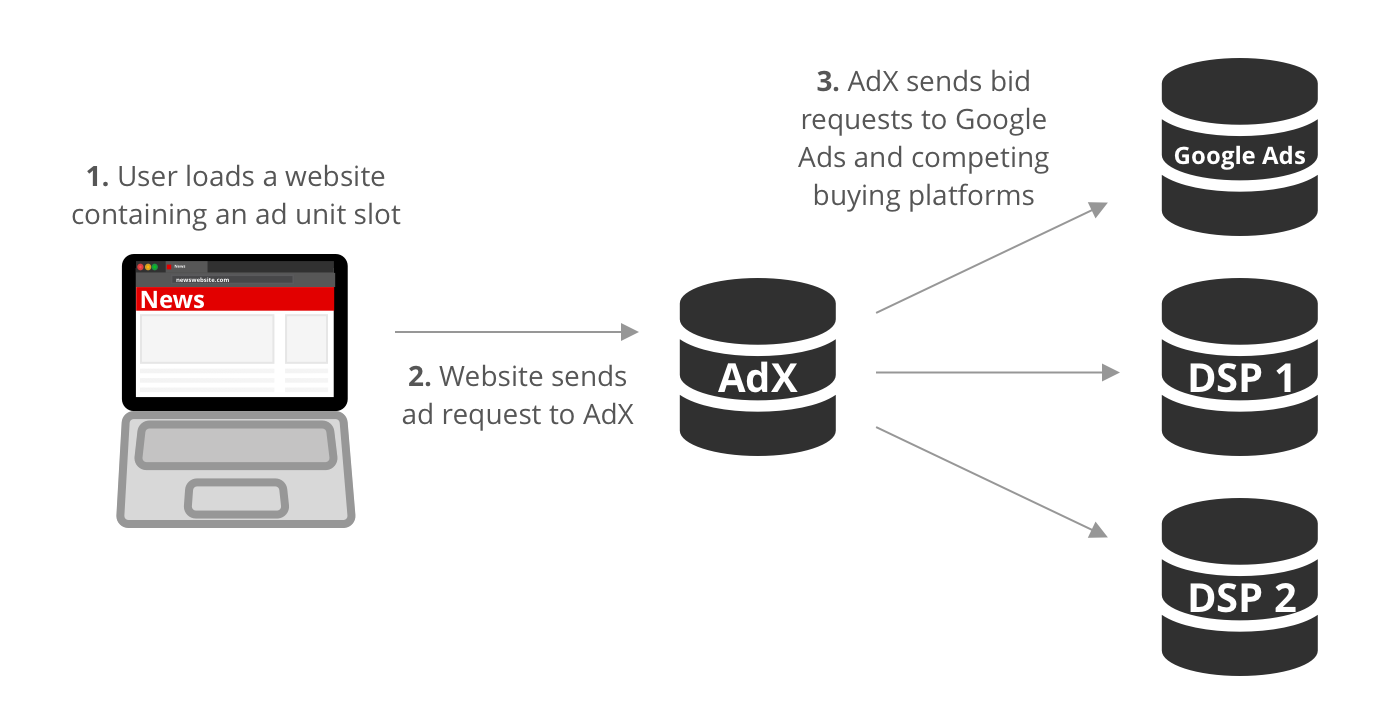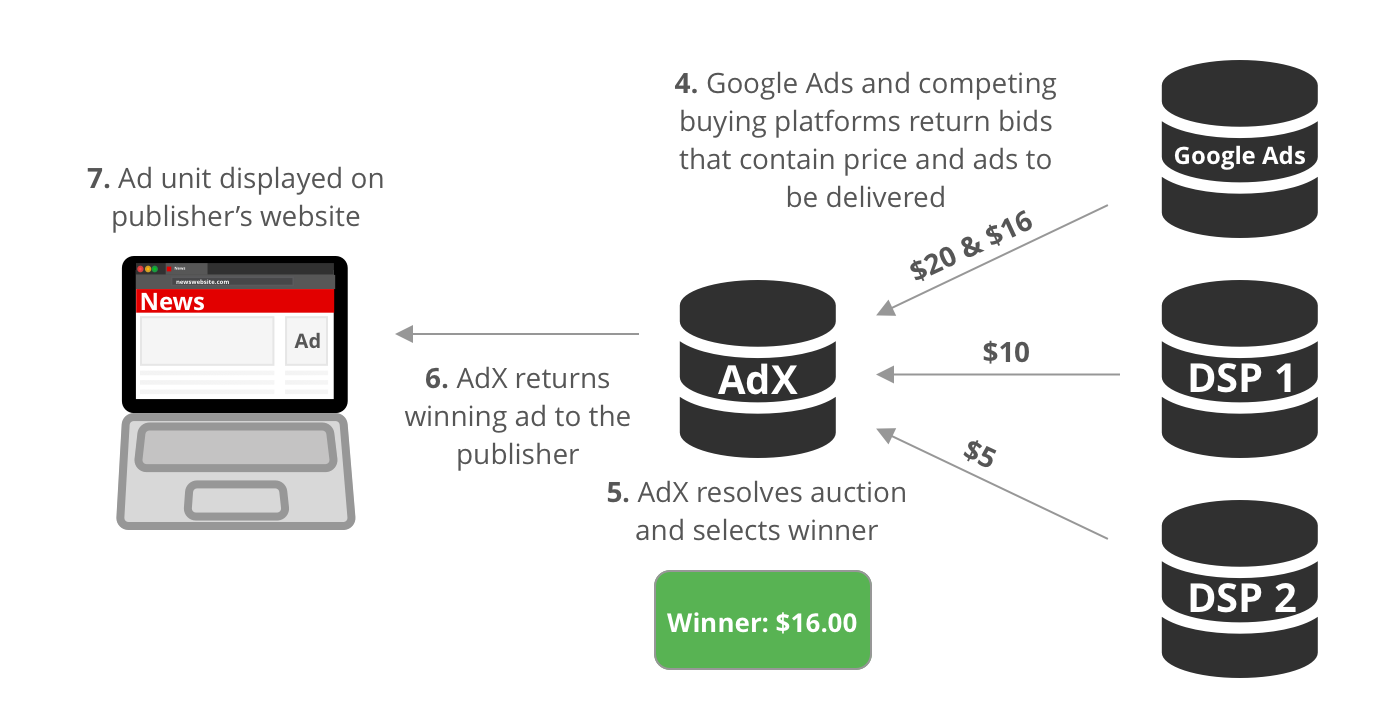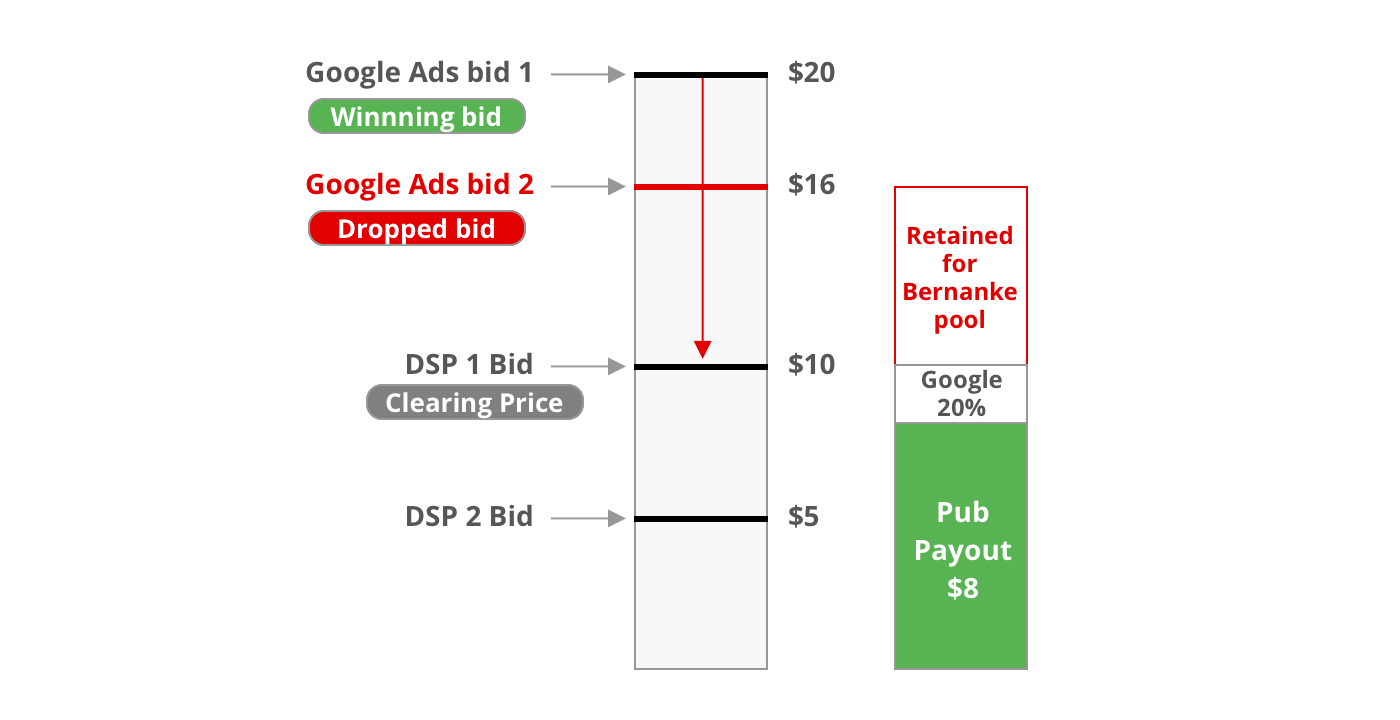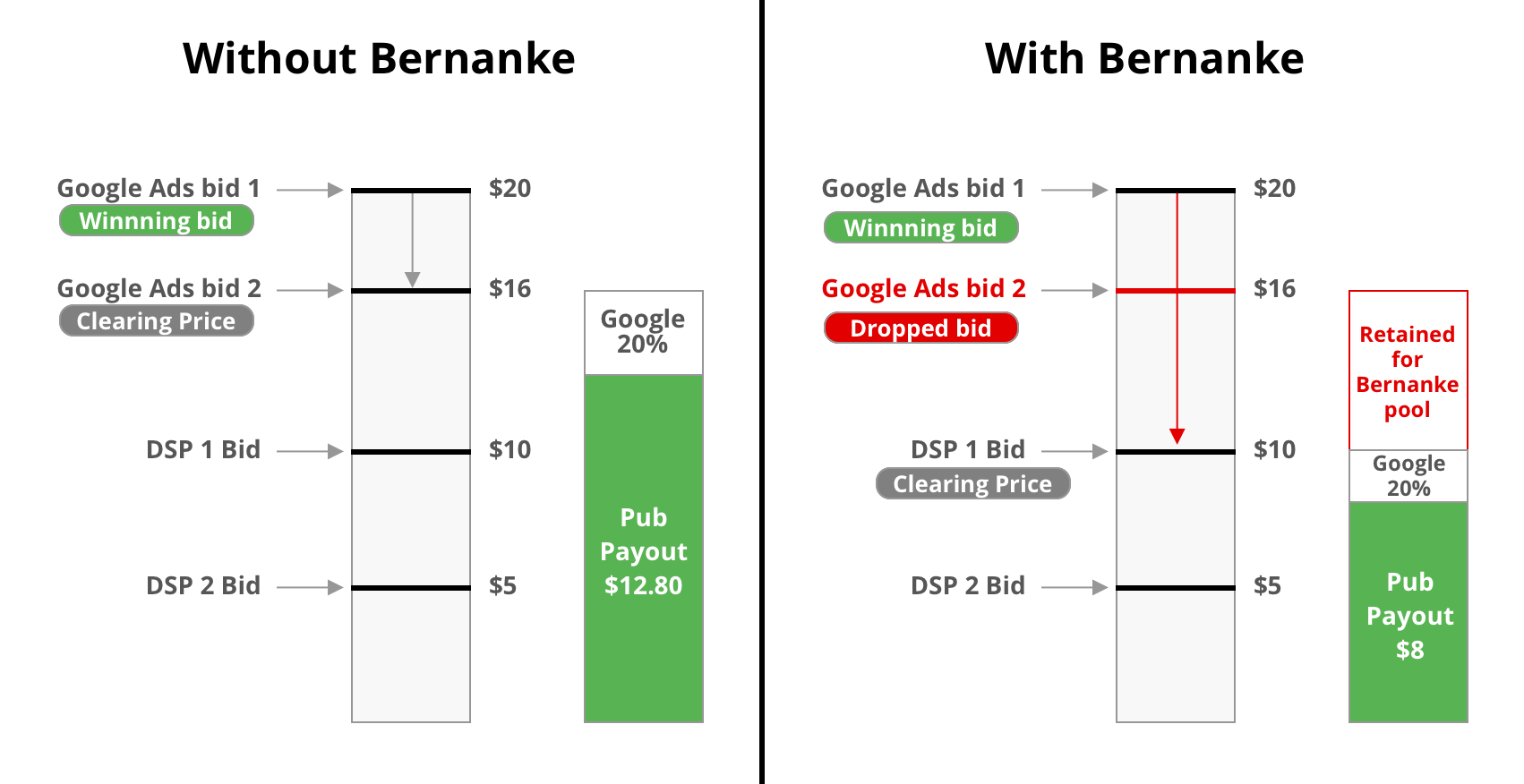We first heard about the internal Google Project, Bernanke, back in April 2021 when unredacted documents related to an antitrust suit against Google mistakenly surfaced.
The documents unveiled that under Project Bernanke, Google used methods undisclosed to its publisher clients to give its advertising clients an edge against advertisers using competitive buying platforms. A federal judge quickly let Google refile the documents under seal.
The Texas-led antitrust lawsuit brought against Google by 15 other states and Puerto Rico alleges that Google used data that amounted to inside information to give its Google Ads buying platform a competitive edge against rivals.
Last week, a New York federal judge unsealed an amended lawsuit that included detailed information about how Project Bernanke worked. The new details clearly explain the allegations — that Google manipulates auctions for advertising impressions using inside information to favor its advertising clients over advertisers using competing platforms.
Explaining Project Bernanke
This article will assume you understand some programmatic advertising basics. At the very least, you should be familiar with real-time bidding. You can read a quick refresher about real-time bidding here.
You should also understand the various roles of Google in the programmatic advertising buying process. Google represents buyers (advertisers), sellers (publishers) and runs the auction process between the two.
Google is not the only company in that advantageous position — but their dominance (Google captures 26.4% of all US digital advertising spend) over the digital advertising industry puts them in a wholly unique situation that we will explore below.
Please note that all of the details below come from the Texas antitrust lawsuit that is publicly available. The purpose of this article is to explain the allegations brought against Google in the filing. Google has not yet had a chance to argue against these allegations in court, and new information could prove any information or conclusions in this post false.
What is Project Bernanke?
Google launched Project Bernanke in 2013 to increase the win rates of its advertiser clients on the Google ad exchange, AdX. Google wanted to ensure clients buying with Google Ads had better performance over advertisers using competing ad buying platforms.
There is absolutely nothing wrong with helping your clients win auctions for advertising impressions more often — the problem is how Google helped them win.
Google modified the auction process on AdX to favor its buyer clients. The changes to the auction could have unfairly stifled competition and decreased the earnings of publishers selling advertising inventory on AdX.
The lawsuit points out that Google knew the project could drop publisher ad revenue and that they did not inform publishers about any changes to the auction process:
Google examined some of the effects of its secret Bernanke program, finding that it drops any given publisher’s revenue by upwards of 40 percent. Stating the obvious, one Google employee observed: “Bernanke is powerful.” Publishers had no idea Google was dropping second highest bids and impacting their revenues in this way.
Google may have misled publishers and advertisers about how it conducted its internal auction process. The deception could have led to drastically reduced payouts to publishers (up to 40% lower according to the lawsuit).
Google has powerful insight into every ad transaction on AdX since the company represents buyers and sellers while also managing the auction between the two. This insight presented an opportunity that ultimately proved too tempting and lucrative to pass up.
How does Project Bernanke work?
Employees named the project after then-Federal Reserve Chair Ben Bernanke. Bernanke initiated a quantitative easing monetary policy following the 2008 financial crisis to create money to buy financial assets from the government and banks to help prop up the economy.
As you will see, Google also introduced a way to create funds with Project Bernanke, meant to prop up their internal advertising economy.
The project instituted a method to siphon spend from Google advertising clients that the company would then use to help other clients win auctions more often.
Advertisers use the Google Ads platform to place advertisements across websites and apps. Publishers make their inventory available to Google Ads advertisers through the Google ad exchange, AdX. Publishers can only make their advertising inventory available on AdX by using the Google ad server solution Google Ad Manager (GAM) or Google Adsense.
Google AdX conducts the real-time bidding process for each advertising impression made available on the platform. AdX collects bids from Google Ads and competing ad buying platforms (DSPs or Demand Side Platforms).
The diagrams below illustrate how this process works. Everything begins when a user loads a website or app containing an ad unit that initiates an ad request to Google AdX.

After AdX sends out requests for bids to its buying platform (Google Ads) and competing DSPs, it receives back bids along with all the metadata necessary to deliver and display an ad.

The bids are submitted as dollar amounts the advertisers are willing to pay per thousand impressions (CPM).
To understand Project Bernanke, you must understand why the winning bid cleared at $16. Even though Google Ads submitted two bids (one for $20 and the other for $16), the $20 bid won, but they will only pay $16. The auction clears at $16 due to an auction mechanic called a second-price auction.
There are two types of auctions, first-price auctions, and second-price auctions. Winners of first-price auctions pay the price they bid. The winner of a second-price auction pays the price of the next highest bid (usually plus a penny, but we want to keep things nice and round).
Google ran a second price auction in 2013 when they initiated Project Bernanke — or at least that is what they told everybody. The lawsuit mentions Google publicly stating this fact multiple times:
Between 2010 and September 2019, Google led publishers and advertisers to believe that AdX was a second-price auction. For example, shortly after launching its AdX exchange in 2009, Google executive Scott Spencer promoted the new product by discussing AdX’s mechanics in an interview published on the popular industry website AdExchanger. Spencer explained: “AdX is a second price auction with minimum CPMs set by the publisher. This is the most efficient auction model, resulting in the most stable, long-term equilibrium price.”
The lawsuit goes on to point out another public declaration that AdX operates a second-price auction:
In their 2014 paper “Yield Optimization of Display Advertising with Ad Exchange” (published in the American Economic Review), Google senior researchers Jon Feldman, Vahab Mirrokni, and S. Muthukrishnan similarly promoted AdX: “With multiple bidders, AdX runs a sealed bid second-price auction.” No doubt, publishers and advertisers were led by Google to believe that when AdX ran an auction, the highest bidder would win and pay the amount of the second-highest bid.
According to the lawsuit, these statements were not accurate. So which type of auction did Google run?
The Third-Price Auction
Google ran a third-price auction. Let's examine how the third-price auction worked and how Google may have abused the auction process to their benefit.
The diagram below illustrates how a second-price auction would function using the bids from the previous diagrams.

The $20 CPM Google Ads Bid 1 wins the auction, but the advertiser would only pay $16 since that is the second-highest bid, and this is a second-price auction. Google would retain 20% of the spend and distribute the remaining 80% to the publisher ($12.80 CPM).
But in the Google Bernanke third-price world, this is how the auction worked:

The $20 CPM Google Ads Bid 1 still wins the auction, but instead of clearing the auction at $16, Google would pretend that Google Ads Bid 2 did not exist and fall back to the third price in the auction ($10 in the example above).
The bombshell here is that Google would still charge the advertiser as if the second price still existed ($16 in the example above) and pay the publisher based on the third-highest bid ($10).
Google then retained the difference between the second and third bid for use in a pool of funds that they would use to inflate bids in other auctions to ensure their advertisers beat out bids from competing buying platforms.

Google manipulated the auction when the two highest bids were from Google Ads and above the auction floor. (Publishers can set price floors to ensure that no bids below the floor are accepted).
If the allegations are true, the surreptitious auction mechanics introduced by Google helped Google Ads outperform rival platforms.
The lawsuit notes that the win rate and the volume of impressions delivered in AdX from advertisers using Google Ads increased dramatically with Bernanke enabled.
Project Bernanke could also allow Google to cherry-pick more valuable impressions by inflating the bid price on high-quality impressions and leaving unwanted or low-value impressions for competing platforms to bottom-feed over. These actions would lead to better performance for advertisers on Google Ads than other ad buying platforms.
The evolution of Bernanke
The first version of Bernanke worked as described above and only designated the pool funds on a per-publisher basis. Google divided the pools by publisher, so Bernanke funds retained would ultimately be distributed back to the same publisher in the form of other inflated bids.
The second version of Bernanke, dubbed Global Bernanke, created a global pool of funds. Google used the global pool to inflate bids when Google Ads bids fell below a publisher's price floor.
The third version, called Bell, may have punished any publisher that did not provide Google AdX with preferential access through a feature called Dynamic Allocation.
Dynamic Allocation was a setting available in Google's former ad server product, Doubleclick for Publishers (now Google Ad Manager). Publishers use ad servers to manage the ad exchanges they use. AdX is one of many exchanges publishers can use to sell inventory.
Dynamic Allocation allowed AdX to view historical bid data from rival exchanges. When publishers enabled Dynamic Allocation, Google only needed to beat the average bid price from competitors, not necessarily the bid price for a given auction.
For example, if a competing ad exchange bids $2.50 on average, Google would only need to bid $2.51 to beat any bids from the competitor.
The feature gave Google the right of first refusal for an impression. Google could choose to beat the average historical bid from an exchange or not bid on an ad impression. Providing ad server technology gave Google valuable insight and a competitive advantage on price and impression selection.
If a publisher did not give Google preferential access to their inventory through Dynamic Allocation, Bell would apply and subsequently drop publisher revenue by up to the Project Bernanke maximum of 40% and siphon the additional funds to pump up Google Ads bids for other publishers.
Is Project Bernanke anti-competitive?
The specific anti-competitive complaint listed in the lawsuit brought against Google that details Project Bernanke is:
Google secretly manipulates auctions to unlawfully exclude competition
Did Google secretly manipulate auctions? If the allegations are true, yes.
The two excerpts at the beginning of this article show that Google publicly stated they run second-price auctions even though they may not have. Even if this is not anti-competitive, it is a poor business practice.
Did this manipulation unlawfully exclude competition? That is for the courts to decide.
Publishers use Google Ad Manager because they need access to Google AdX. Publishers need access to Google AdX because the volume of Google Ads spend is too big to ignore.
Advertisers use Google Ads due to its access to Google Search advertising and because it performs better than competing ad platforms buying inventory on Google AdX.
The new information outlines that the Google Ads platform may perform better because Google allegedly:
- Siphons funds from one of its buyers to help others
- Has access to competing bid information (that they indirectly pressured publishers to provide)
Google plays all sides of ad transactions, giving them an almost omnipotent vantage point that competitors could only dream of achieving. Google can use its access to publisher floor information and competitor bid information to augment auctions (maintained by them) to favor its buying clients.
Publishers and advertisers need to use Google advertising products, and the company may be capitalizing on this need to entrench its dominant position in the digital advertising industry.
Is this a masterful display of sweet sweet capitalism or a nefarious exhibition of anti-competitive behavior? Stay tuned!
Did Project Bernanke hurt Google's publishers and advertisers?
At first glance, you could deem Project Bernanke hurt both publishers and advertisers. The third-price auction mechanic led to drastically reduced payouts for publishers and charged advertisers more than they should have.
These changes directly benefited the bottom line of AdX. From the lawsuit:
In just the first year of launch, the Bernanke program alone swelled trading in AdX enough to increase annual revenue by a staggering $230 million. Google’s internal documents project Bell to generate Google an additional $140 million per year
But Project Bernanke also helped Google advertisers:
Google reflected that in just the first year of launch, Google increased its small advertisers’ win rate on AdX by +20 percent.
Even though Google was not forthright in how the auction worked, they did increase advertiser win rates.
It is not entirely clear whether Project Bernanke led to lower publisher revenue in total. The lawsuit only alleges that publishers earned less in the context of some single auctions.
The introduction of inflated bids in other auctions could have led to a wash or even more revenue depending on the frequency at which it happened. Google may argue that they redistributed funds in a way that led to higher overall publisher payouts for AdX publishers.
However, it is possible that Project Bernanke unfairly hurt advertisers who use buying tools other than Google Ads since those tools would prove to be less effective on AdX. So while Google may have helped its clients, the specter of antitrust lingers.
Photo by Pawel Czerwinski on Unsplash


